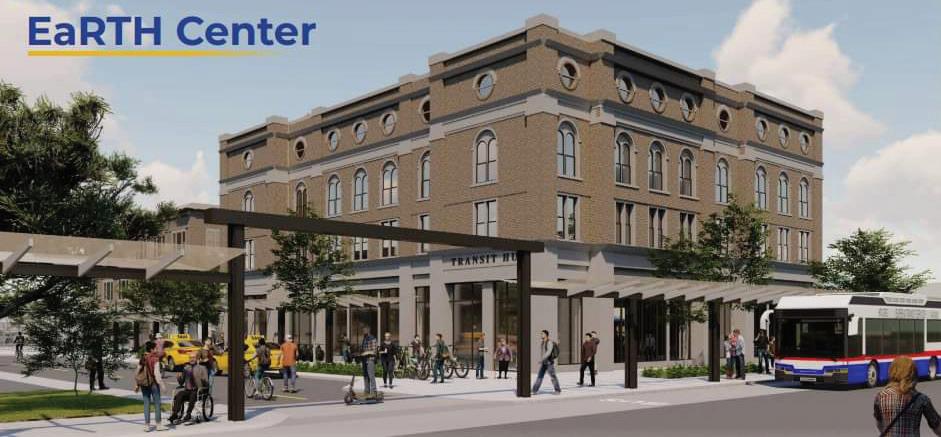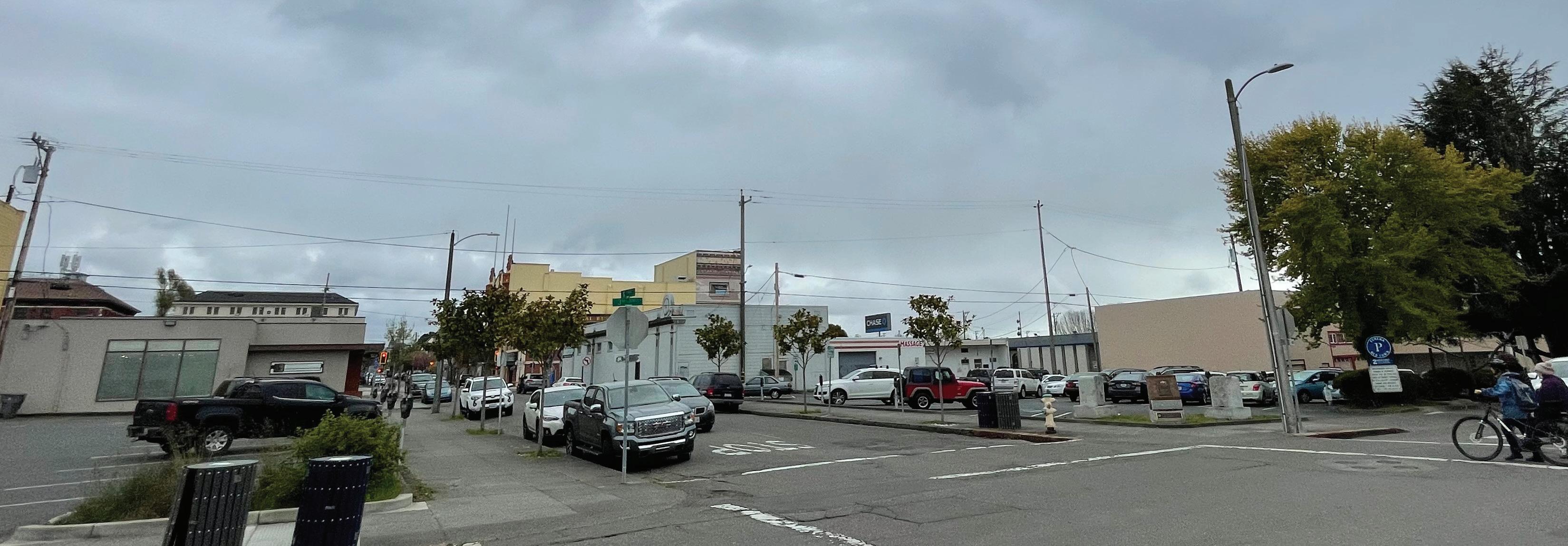
7 minute read
On The Cover
The Eureka City Council recently approved the multi-use Eureka Regional Transit and Housing Center (EaRTH Center) proposed to be built on the parking lots of Third and H Streets in Old Town Eureka.
City of Eureka Facebook
Parallel Crises
Humboldt desperately needs housing but how it’s built may determine the county’s role in combating climate change
By Elaine Weinreb
newsroom@northcoastjournal.com

If you’ve tried to find housing in the last few years, you know what a difficult task it is. Humboldt County property managers say local rental vacancy rates run between 0 and 3 percent — extreme, even in California, which has a roughly 4-percent vacancy rate statewide.
Buying a home in Humboldt is also cost-prohibitive for most people, with the median price for a single-family home coming in at $451,000, according to statistics published by the California Association of Realtors. Homes for sale in Humboldt also only stay on the market for an average of 12 days before they are snapped up, another indication of a significant housing shortage.
The reasons are multiple and include climate and wildfire refugees, as well people fleeing the city since COVID-19 enabled people to work from home. But the underlying issue is that demand for housing has outstripped the supply. The obvious answer is to build more housing, but that is a lot harder and more complicated than it seems.
“California housing has become the most expensive in the nation,” states the preamble to Senate Bill 9, the Affordable Housing Act. “The excessive cost of the state’s housing supply is partially caused by activities and policies of many local governments that limit the approval of housing, increase the cost of land for housing, and require that high fees and exactions be paid by producers of housing.”
The state has stepped in with both sticks and carrots to get communities to increase their housing stocks. One such law is Senate Bill 9, which basically does away with single-family zoning. Under S.B. 9, property owners need only get a simple ministerial building permit to add a second home on their lot. Each of these two homes can also have an additional “granny flat” or be divided into duplexes, resulting in four housing units on a lot zoned for single-family use. Some California cities have resisted what they believe to be an illegal incursion into local control and are filing suit against the state for violating the California Constitution’s legal designation for charter cities.
Several cities in the San Francisco Bay Area, meanwhile, have reported that almost no landowners are taking advantage of these loosened restrictions. Here in Humboldt, County Planning Director John Ford reported that his department had seen an “uptick” in building permits for accessory dwelling units but was not specific as to the numbers. Likewise, Eureka City Manager Miles Slattery expects there will be an increase in people wanting to increase the housing density on their properties because it will increase their value.
City and county planners are familiar with the state’s Regional Housing Need Allocation (RHNA, pronounced ree-na). In 2019, the California Department of Housing and Community Development presented each individual county with a requirement to build a certain number of new housing units by 2027. While the state cannot require the county or city to actually construct or pay for the units, it establishes that local governments cannot prohibit such building through restrictive zoning codes, and requires they change their codes, if necessary. These code changes are supposed to be reflected in the Housing Element of the county or city’s General Plan.
It is not easy to determine how the state comes up with RHNA numbers for each locality, but, according to Humboldt County Association of Governments (HCAOG) Senior Planner Oona Smith, it is a formula based on census population data and on the number of jobs a region offers.
The state wants 3,390 new housing units built in Humboldt by 2027. Of these, 829 must be affordable for very low-income households, 532 for low income, 613 for moderate income and the rest for above average income households. The figures are further broken down by HCAOG into allocations for the seven incorporated cities and the unincorporated areas of the county.
These RHNA numbers are supposed to be reflected in the Housing Element of the city or county’s General Plan,
which must also be updated periodically.
Failure to meet RHNA goals can result in difficulty in obtaining state grants. Compliance gives the jurisdiction “brownie points.”
While there are different definitions of “affordability,” most agencies feel that housing costs should not take up more than a third of a family’s total income. For a family with a single wage earner, making $60,000 a year, that would be about $1,666 per month.
California, particularly under the Newsom administration, places a strong emphasis upon infill. There are two reasons for this: One is the protection of natural resources; the other is directly associated with climate change. The more miles people drive to work each day, the more emissions from their cars contribute to global warming. If jobs and housing are both available in the same area, theoretically, the number of vehicle miles traveled would be reduced, resulting in fewer greenhouse gas emissions.
In the past, Caltrans’ primary objective was to keep traffic moving, both in towns and on the highways, with as little delay as possible, keeping air pollution to a minimum. Recently, this objective changed to reducing the total number of vehicle miles traveled, hopefully leading to a diminution of greenhouse gases. Plans for new development are supposed to reflect this transportation goal.
Humboldt has many limitations on where new housing can be built. To meet the RHNA requirements, new housing must be in areas that already have municipal services, such as public water and sewage treatment systems. That eliminates many of the more far-flung regions of the county. The California Coastal Commission limits what can be built near the coast. Forests, floodplains, marshlands and agricultural lands all have various degrees of legal protection. That leaves only one direction — upward.
In recent months, Humboldt residents have considered three different styles of urban development. In Eureka, city officials are considering building affordable housing on city-owned parking lots. This has resulted in pushback from local businesses, who fear that a lack of parking will discourage people from shopping, though Slattery does not think the loss of a few parking lots would harm the

4/20 APPAREL
Available Now

(707) 822-9330 | HEARTHUM707 601 I St, Arcata www.theheartofhumboldt.com
Feeling tipsy?
If you have a news tip, story idea or something you’d like to see covered, we’d love to hear from you!

“Primary Opportunity
Sites” City of Arcata’s Gateway Area Plan

city’s business community.
In Arcata, the city wants to re-zone a large swath of formerly industrial land that is now largely vacant and under-utilized. Known as the “Gateway Area Plan,” a variety of buildings of all sizes would be constructed, including some as high as eight stories. Most would be for housing, but retail and light manufacturing would also be permitted. Roadways would be designed to encourage bicycling and walking, and the area would be enhanced by open green spaces.
In the Cutten area, which is under the county’s jurisdiction, an 81-acre tract of land, the North McKay Ranch Project, is planned for a more traditional type of development — with 146 new single-family houses and 174 units in multi-family structures. Municipal services, such as water, sewer and gas lines, would be constructed, making the project eligible to meet RHNA goals. However, this would necessitate the clearing of forestland and is being opposed by a number of environmental groups, which have threatened to sue the county over it.
Each of these projects has its upsides and downsides. Although the Gateway Project seems to fit in with the environmental goals that many Arcatans espouse, some residents feel it would change Arcata’s small-town rural atmosphere to one of a city, a change they resent.
Additionally, the Arcata Fire Department does not have the equipment to deal with high-rise buildings. Much of the land in Arcata’s Gateway Area was used for industrial sites and may be polluted. Ground pollution can be expensive and difficult to clean up. As an example, a prime piece of Arcata real estate, located near the plaza, has stood empty for decades because after the building it supported burned down, the ground was found to be polluted. Some people also question the wis-








